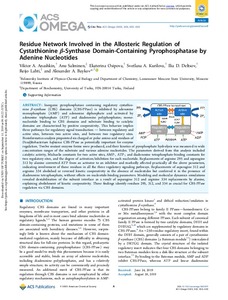Residue Network Involved in the Allosteric Regulation of Cystathionine β-Synthase Domain-Containing Pyrophosphatase by Adenine Nucleotides
Viktor A. Anashkin; Anu Salminen; Ekaterina Osipova; Svetlana A. Kurilova; Ilia D. Deltsov; Reijo Lahti; Alexander A. Baykov
https://urn.fi/URN:NBN:fi-fe2021042827345
Tiivistelmä
Inorganic pyrophosphatase containing regulatory cystathionine β-synthase
(CBS) domains (CBS-PPase) is inhibited by adenosine monophosphate (AMP)
and adenosine diphosphate and activated by adenosine triphosphate (ATP)
and diadenosine polyphosphates; mononucleotide binding to CBS domains
and substrate binding to catalytic domains are characterized by positive
cooperativity. This behavior implies three pathways for regulatory
signal transduction — between regulatory and active sites, between two
active sites, and between two regulatory sites. Bioinformatics analysis
pinpointed six charged or polar amino acid residues of Desulfitobacterium hafniense
CBS-PPase as potentially important for enzyme regulation. Twelve mutant
enzyme forms were produced, and their kinetics of pyrophosphate
hydrolysis was measured in wide concentration ranges of the substrate
and various adenine nucleotides. The parameters derived from this
analysis included catalytic activity, Michaelis constants for two active
sites, AMP-, ATP-, and diadenosine tetraphosphate-binding constants for
two regulatory sites, and the degree of activation/inhibition for each
nucleotide. Replacements of arginine 295 and asparagine 312 by alanine
converted ATP from an activator to an inhibitor and markedly affected
practically all the above parameters, indicating involvement of these
residues in all the three regulatory signaling pathways. Replacements of
asparagine 312 and arginine 334 abolished or reversed kinetic
cooperativity in the absence of nucleotides but conferred it in the
presence of diadenosine tetraphosphate, without effects on
nucleotide-binding parameters. Modeling and molecular dynamics
simulations revealed destabilization of the subunit interface as a
result of asparagine 312 and arginine 334 replacements by alanine,
explaining abolishment of kinetic cooperativity. These findings identify
residues 295, 312, and 334 as crucial for CBS-PPase regulation via CBS
domains.
Kokoelmat
- Rinnakkaistallenteet [27094]
